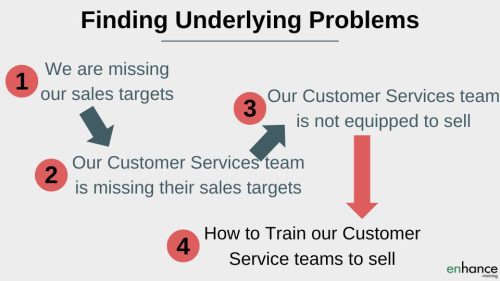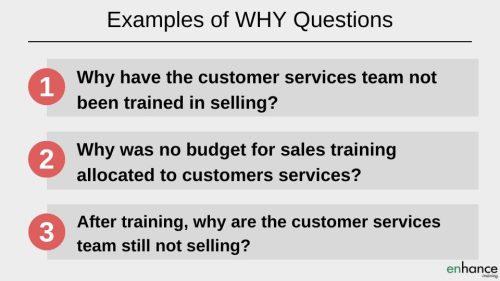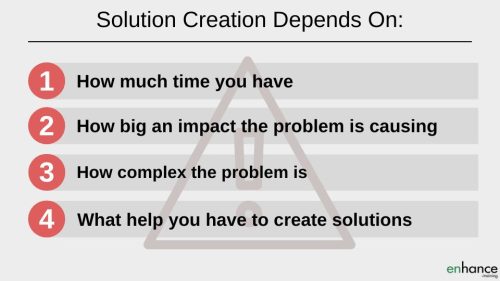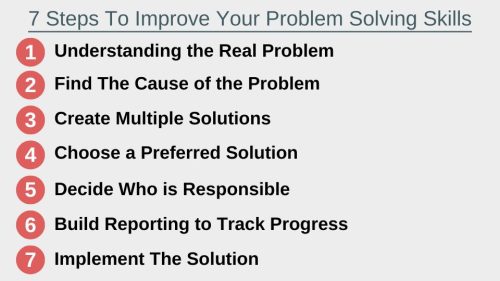7 Steps to Improve Your Problem Solving Skills at Work

Improving your problem solving skills at work is critical to improving your career prospects. Every business needs and loves good problem solvers. Every business has a massive range of problems to solve each day, each week. So the more skilled their staff members are in solving problems at work, the more valuable those staff become, and the more likely they are to be promoted to solve even more challenging problems.
The best part is everyone can become a good problem solver with practice. Problem solvers are made not born. Learn effective problem solving steps and practice problem solving and you will improve.
Problems are scary when we don’t have the tools, frameworks or understand the steps to solve a problem at work we are facing. As we gain more experience of problem solving, we recognise more problems and which framework or set of steps worked to solve that problem before or one like it.
The better problem solvers recognise more types of problems and have a wider range of ways to solve problems at work.
7 Steps to Improve Your Problem Solving Skills at Work
- Understanding the real problem
- Find the cause of the problem
- Create multiple solutions
- Choose a preferred solution
- Decide who is responsible for implementing the solution
- Build reporting to track progress
- Implement the solution to the problem
Watch on YouTube
Listen on Podcast
Most problems can be solved quickly at work because you, your colleagues or your manager come across them regularly and know the steps to solve problems being faced.
For the new problems that no-one has solved before, or for the problems that have not been solved very well before, go through these 7 steps to improve problem solving skills at work
In my view, the most important step to improve your problem solving skills at work is
Understand the real problem
If you don’t understand the real problem then it is almost impossible to come up with effective steps for problem solving. The symptoms or issues that you are experiencing will continue.
Be patient and spend as much time as you need to really understand what problem you are dealing with. Don’t rush this step no matter how much pressure is on you. Get this step wrong and you will waste a lot of time and look silly.
When evaluating the problem, don’t just rely on your colleague’s or teams’ opinions. Treat their opinions as valuable starting points so you investigate the right area. Dig into the facts and the data to get raw information on the problem. Opinions alone are too subjective. Find the right data and you have an unbiased picture of what is happening.
Keeping digging down and asking yourself if this is the underlying problem that is causing all the issues you are experiencing. When you run out of problems that are causing subsequent problems, you should have found the underlying problem.
Never take a problem at face value without investigating further and checking for underlying problems.
A simple example
of this process might be:
The obvious problem is “We are missing our sales targets”.
Digging into the sales achieved versus the targets set out by department, you discover the Customer Services team has the largest gap in missed sales.
The next problem becomes, “Our customer services team is missing their sales targets”.
Speaking to the customer services team, you discover that they don’t believe they have enough selling skills, they aren’t confident in selling and therefore generally are not selling when they could.
The problem becomes, “Our customer service team is not equipped to sell”.
After conversations with the sales, customer services and leadership teams, the problem becomes “How to train our customer services teams to sell”. This is the underlying problem we need to solve.
This underlying problem looks a lot different from the initial problem we started with. Solving the underlying problem will solve all the other problems through the chain including the initial problem we started with. When you see this pattern and can’t go any further, you have usually found your underlying problem.

Find the cause of the problem – Vital to improve your problem solving skills
Once you understand the underlying problem you need to solve, investigate and find the causes of that problem. Causes of problems at work are rooted in decisions, actions or behaviours of individuals or teams. If you don’t address the cause of the problem, the problems you have will keep persisting.
A good route to finding out all the possible causes of the underlying problem is to keep asking why until you have discovered and captured all the causes of the problem.
Some example Why Questions include:
“Why have the customer services team not been trained in selling?”
“Why was no budget for sales training allocated to customer services?”
“After training, why are the customer services team still not selling?”
Just remember, there may be more than one cause to the underlying problem you are facing. Spend time finding all the likely causes by asking lots of questions (Improve your questioning skills). The more causes of a problem you find, the better and more robust you can design a solution thus improving your chances of solving the problems first time round.

The next step to improve your problem solving skills at work is to
Create multiple solutions – Step 3 to Improve your problem Solving Skills at work
How many solutions to a problem you create depends on a number of factors including:
- How much time you have
- How big an impact the problem is causing
- How complex the problem is
- What help you have to create different solutions
If you are tackling a low impact problem without much time to solve it, don’t try to create 15 different potential solutions. The amount of time spent to create additional solutions is very unlikely to improve the final solution sufficiently to justify the time spent. Use your judgement.
For problems with bigger impacts on company results or staff motivation for instance, make more time to create multiple solutions.
Multiple solutions give you choices. You can compare the pros and cons of different solutions against each other.
When you have a challenging problem to solve, break it down into smaller more digestible problems. Solving lots of smaller problems is mentally much easier than solving one large problem.
Do get other people involved. The solution creation process is a lot easier, quicker and generates better solutions when multiple people are involved. This is because the different experiences, views, thinking processes and ideas of each person spark additional thinking, ideas, challenge, and further solutions in the other members of the group.
Use small teams to solve the more challenging problems.

The fourth problem solving step is to Choose a preferred solution
Making a decision, even a bad one, is nearly always better than making no decision. So choose your preferred solution.
This should be the option that addresses all or most of the causes of the underlying problem. Consider the time, resources and critical failure points of each solution when evaluating them. Choose the solution that is most likely to be implemented or implemented well.
Ensure your preferred solution has a start and an end point and you have detailed out the steps that need to be taken to move from the start to the completed solution. If you can’t practically implement a solution, then it is not a solution.
Once you have your preferred solution to the underlying problem then the next step to improve your problem solving skills is to
Decide who is responsible for implementing the solution
Choose a single person to be responsible for implementing the solution. The person responsible does not always do all the work. They make sure the solution is implemented correctly and deal with problems that come up during implementation.
You should answer:
- Who is doing what
- When are they doing their tasks and activities, and what is the deadline for completion
- What standard of work is needed
- What resources do they have available to them
If you are a manager delegating to a team member, you will retain some responsibility to ensure the solution is fully implemented.
The sixth step to improve your problem solving skills at work is to
Build reporting to track progress
All parties should be clear on what a correctly implemented solution should look like when it is finished.
Before you start implementing the solution, agree how you are going to measure progress towards completion. Keep this proportional to the importance and complexity of implementing the solution.
For the simpler projects, agreeing the finish line and a way of tracking progress, if needed, is likely to be sufficient.
For the larger, complex or more important projects solving specific problems, build reporting or Key Performance Indicators (KPIs) to track exactly how progress is going. Match the reporting to the critical activities being undertaken in each phase of the project implementation.
Good reporting gives you visibility and a degree of control over the implementation of the solution without needing check on all the detail. Use it to spot and deal with problems that come up. Also share reporting with key stakeholders so you limit surprises.

Finally, The seventh step to improve your problem solving skills at work is to
Implement the solution to the problem
Undertake the steps, tasks and activities to implement the solution to the problem. This is a very important phase so stay close to what is going on so you can provide support and help resolve issues that arise.
A solution that has not been implemented is just a nice idea. It is not a solution.
Do take a look at How To Execute and Make Things Happen for more on the implementation phase.
in summary
Improve your problem solving skills to progress your career at work. It absolutely doesn’t matter what you do – every job has plenty of problems to solve. Improve your methods for problem solving and your problem solving skills and you will get promoted a lot more.
Problem solving at work to a point is what makes most jobs more interesting and enjoyable.
Just to recap the 7 steps to improve your problem solving skills at work are:

You should use these steps to solve any work problem.





